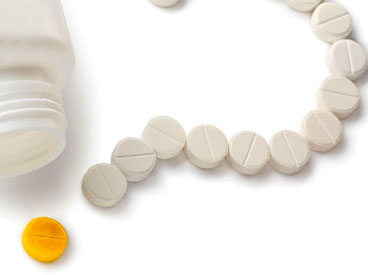Dr. Nortin Hadler refuses to let anyone measure his cholesterol. An avid cyclist who adheres to a healthy diet, does not smoke, and doesn’t have heart disease, Hadler, a professor of medicine at the University of North Carolina, knows that a reading above 200 for total cholesterol and/or above 130 for LDL (“bad”) cholesterol is likely to make his internist whip out the prescription pad and send him to the pharmacy for a statin, one of the widely prescribed drugs that lower cholesterol. And that doesn’t sit well with Hadler. More than a dozen studies, he points out, have shown that in an otherwise healthy person with no history or symptoms of heart disease, taking statins provides zero benefit.
That’s right. Zero. Statins—Lipitor, Crestor, Pravachol, Mevacor, Zocor, and their generic equivalents—today reside in the pill dispensers of a huge segment of the population over 45, but for heart-healthy patients, statins will not increase longevity, prevent a fatal heart attack, or avoid a life-ending stroke.
So if taking statins won’t keep you alive and healthy any longer than not taking the pills, Hadler asks—especially when you consider possible side effects ranging from muscle pain and fatigue to liver damage to increased risk of diabetes and even memory loss—what’s the point in knowing your cholesterol numbers?
Cardiologist Eric Topol is equally scathing about statins. Chief academic officer of Scripps Health, a nonprofit health care system based in San Diego, Topol has long believed that medicine must become personalized with treatments tailored to a patient’s DNA and other characteristics. Yet statins are the poster child of taking a drug that benefits some people and then prescribing it to many more. In his new book, The Creative Destruction of Medicine, Topol points out that only one or two out of 100 patients “without prior heart disease but at risk for developing such a condition will actually benefit” from a statin. To which he asks, “how about the 98 out of 100 patients who don’t benefit?”
To put these views in perspective, statins are associated with one of the greatest public health triumphs of the past 30 years: halving America’s death rate from coronary heart disease. From 543 per 100,000 men in 1980 the death rate fell to 267 deaths per 100,000 (adjusted for the aging of the population) in 2000. From 263 deaths per 100,000 women in 1980 it fell to 134 per 100,000 in 2000, data from the U.S. Centers for Disease Control and Prevention show.
Looking at it another way: As a result of the lower death rate from coronary heart disease, 341,745 fewer Americans died in 2000 alone.
That sounds pretty spectacular, but the crux of the debate lies in whether statins have a benefit in primary prevention—reducing heart attacks and strokes in patients without known heart disease. There’s no argument about the benefits of statins for secondary prevention—averting a heart attack or stroke in people who have already had one. For example, the 1994 Scandinavian Simvastatin Survival Study—still considered the definitive statin study—showed that treating patients with pre-existing heart disease decreased their chance of dying over five years from 12 percent without statins to eight percent with the drugs; their chance of cardiac death, heart attack, or needing heart surgery fell from about 30 percent without statins to about 20 percent with them also over five years. “If you’re in this category, you would definitely want to take a drug that decreased your chance of dying or having a major cardiac event by a third,” says Dr. Eli Farhi, an assistant professor of cardiology at the University at Buffalo School of Medicine and Biomedical Sciences.
Primary prevention is another matter, however. These are the people Hadler, Topol, and other critics focus on when they discuss the statin problem. Consider two of the most rigorous and widely cited clinical trials of statins: In one, three people of every 100 without pre-existing heart disease but with high cholesterol who took a placebo pill suffered a heart attack; two of every 100 such people taking the best-selling Lipitor did. In the other trial, four of every 100 volunteers taking placebo had a non-fatal heart attack or stroke while two of every 100 taking Crestor did. These results are typical of the findings of other studies. As Topol notes, the bottom line is that the most popular statins reduce the risk of having a heart attack or stroke from three or four percent to two percent.
That’s not very significant. A 2011 analysis that reviewed 14 randomized trials and over 34,000 patients compared the tiny benefit with the very real risks of diabetes and muscle pain or weakness the drugs pose and concluded, “there was no net overall benefit of statins for patients without pre-existing heart disease,” notes Topol.
The key phrase here is “without pre-existing heart disease.” But most general practitioners take their cue from cardiovascular specialists, and many of these experts believe that statins save lives, period. Theirs is a straightforward argument: Cholesterol is bad; therefore, lowering cholesterol is good. “If someone has high LDL as well as high blood pressure or a history of smoking or other risk factors such as age and gender, let’s take that one risk factor [elevated cholesterol] out of the equation,” says Cleveland Clinic’s Dr. Marc Gillinov, co-author of the new book Heart 411. (Indeed, Topol himself, once one of the fiercest advocates of statin drugs, wrote in The New England Journal of Medicine as recently as 2004 that “statin drugs have already surpassed all other classes of medicines in reducing the incidence of the major adverse outcomes of death, heart attack, and stroke” caused by atherosclerotic vascular disease.)
Statins, first introduced in 1987, lower blood cholesterol levels by affecting how much of the substance the liver produces, how much the intestines absorb, or how much circulates. Study after study, going back to the late 1980s, has concluded that statins lower the risk of heart disease, heart attacks, and stroke. Research into statins won the 1985 Nobel Prize in Medicine for Michael Brown and Joseph Goldstein. No wonder statins rang up U.S. sales of $14.3 billion in 2009. One-fourth of Americans 45 and older take statins according to the National Center for Health Statistics.
“Statins clearly decrease one’s chance” of having a heart attack or stroke, agrees Buffalo’s Farhi. But the real-life importance of the decrease depends on how high your risk is in the first place. If your 10-year risk is extremely slim—a value judgment, but many clinicians regard anything under 10 percent as low—then “it would be of minimal benefit to take a statin,” says Farhi. “You could treat thousands of such people without preventing a single event.”
One useful way to look at the data is to consider something called “number needed to treat” (NNT). NNT simply means how many people must be given a medication, undergo surgery, have a diagnostic test, or have any other medical intervention in order for a single one of them to benefit from it. That number can be surprisingly high even for interventions with unquestioned benefits. For instance, 16 people with open fractures need to receive antibiotics for one to benefit; eight people need to take inhaled steroids during an asthma attack to prevent one from going to the hospital. In each case the vast majority of people would not have developed infections or needed a trip to the ER, respectively, even without the intervention. The NNT in these cases is 16 and eight.
Statins for primary prevention have a stratospherically higher NNT. Sixty people would have to take a statin for five years for one to avoid a heart attack; 60 is the NNT for avoiding this outcome. And 268 people without heart disease would need to take a statin for five years for one person to be saved from a stroke; 268 is therefore the NNT for avoiding this outcome, explains Dr. David Newman of Mount Sinai Medical Center in New York, who maintains an NNT database at thennt.com.
It’s one thing to talk about population-wide research. The challenge, of course, is determining the risks or benefits to any individual. To use an extreme example, a person riding in an airplane that’s headed for the side of a mountain is at very low risk of dying from heart disease. On the other extreme, “If you’re a 50-year-old smoker with very high cholesterol and everyone in your family has died of a heart attack before the age of 40, you would probably be very interested in something that decreases the risk of a heart attack,” says Farhi. Most people fall between these two extremes. You can gauge your risk of having a heart attack in the next 10 years by visiting hp2010.nhlbihin.net/atpiii/calculator.asp.
The National Cholesterol Education Program calculator cited above can also be used to show why lowering cholesterol, as statins indisputably do, fails to make much difference in whether or not you will develop cardiovascular disease. After you’ve typed in your actual cholesterol, blood pressure, and other data, notice what happens if you change the cholesterol: In many cases, it alters the risk of a heart attack by little or nothing. A 55-year-old non-smoking woman with total cholesterol of 240 (high enough to make most physicians prescribe a statin), HDL (good cholesterol) of 50 (which is quite low), and systolic blood pressure of 110 has a 1 percent chance of having a heart attack over the next decade, for instance. Now change her total cholesterol to 190—a huge decline. Her risk is still 1 percent. A 65-year-old man with those first numbers has an 11 percent chance of having a heart attack over the next decade; lowering his cholesterol to 190 brings that down to 9 percent.
In other words, cholesterol levels are not as strongly predictive of cardiovascular disease as once thought. “This has shocked everyone,” says Newman. “Cholesterol levels are actually a fairly weak predictor of who will have a heart attack.”
Might statins provide benefits unrelated to cholesterol reduction? There is some evidence that they also decrease inflammation. (When inflammation occurs in the arteries, it is thought to increase the risk of heart disease.) A 2008 study called the JUPITER trial tested statins in about 18,000 people with normal LDLs but elevated C-reactive protein, a measure of inflammation. Statins reduced the risks of heart attack and stroke. That led proponents to conclude that by working through an additional mechanism—lowering inflammation, not just LDL—statins were helping even people with normal LDL levels. Critics of the study note that it was halted earlier than planned (when people on statins were having fewer cardiovascular events than those not taking the drugs), which can produce a misleading result.
Whether cutting your risk of having a heart attack over the next 10 years from 11 percent to 9 percent, as in our hypothetical 65-year-old man who slashed his cholesterol, is meaningful depends on your perspective. But physicians who question the benefit of statins note that no medication is without risk—and statins are no exception. One known side effect is muscle pain or weakness. About five percent of people taking statins develop this, though in most it goes away when they stop taking the drugs. Another is diabetes. One person in 167 who take a statin for five years will develop diabetes. Newman points out that among people taking statins for primary prevention, the risk of diabetes is greater than the benefit in stroke reduction. Indeed, a 2012 study by the Mayo Clinic as reported in the Archives of Internal Medicine found that the use of statins in postmenopausal women is linked to an increased risk of new-onset diabetes of 71 percent. And in February, the FDA announced what it called “important safety changes” in the labels required on statins. Beginning immediately, the labels will have to warn patients that the drugs have been reported to cause certain cognitive effects in some patients, including memory loss and confusion; when patients stopped taking statins, these problems disappeared. The labels will also have to warn that increases in blood sugar (hyperglycemia) have also been reported, and that the FDA is aware of studies showing that statins may increase the risk of type 2 diabetes.
As we were going to press, a new study was reported in The New York Times suggesting that taking statins makes it harder to exercise. The study, by French scientists, found that lab animals taking statins couldn’t run as far as a control group on a placebo. And a 2005 study that looked at human subjects had similar findings: “It seems possible that statins increase muscle damage” during and after exercise “and also interfere somewhat with the body’s ability to repair that damage,” Dr. Paul Thompson, the chief of cardiology at Hartford Hospital in Connecticut and senior author of the study, told the Times.
How many people might be taking statins despite having only a slim chance of benefiting? Experts can give only rough estimates, but the numbers are clearly in the millions. No one currently taking a statin should stop the medication without talking to his or her doctor, of course, but “it doesn’t make sense to treat all these low-risk people with statins,” says Farhi. “The effect is indeed ‘cosmetic,’ improving their cholesterol numbers without producing any measurable difference in clinical outcome.”
He adds: “Doctors who put everyone on a statin without considering whether they’re likely to benefit are doing their patients a disservice.”
Become a Saturday Evening Post member and enjoy unlimited access. Subscribe now




Comments
Oh forgot. And also sorry about the 4747. Its just 47 “). Lol. But I am on plavix 75. Crestor 20. Fish oil 2 aday. Co q10 2 times aday. ASPRIN 81MG 1 ADAY. PEPCID 20 MG 2X ADAY. ALMOST 3 INCH STENT IN LAD. ALSO KEEP STOMACH PROBLEMS. JUST ALWAYS SICK. IF I HAVE A GOOD DAY I REJOICE ABOUT IT. CAUSE GOD KNOWS I’m for THANKFUL. Note. First they said my lipid profile test come back. Sorry don’t understand. But with like FAT deposits. Next test 3 mths later. LDL up to 100. Thats why they uped Crestor to 20mg. ……… HELP! HELP! HELP!
There is a great new book out,written by Dr Barbara Roberts, a leading NYC Cardiologist, (who was part of the first team of Docs who wrote about Cholesterol as a Cardiac risk factor),its called the “Truth about Statins”She is not a big fan of Statin drugs.She is one of the top Cardiologists in the USA and this book should be read by all who are taking or considering taking these agents.
In today’s medical climate it is easy to forget that we are the sole proprietors of our bodies. Doctors do not have shared ownership with us. The only time that a doctor can make you take a drug is if you are unconscious in a hospital. In all other situations, you get to decide whether to take something or not.
It is so disheartening to read about people who think they are required to take a statin unless they can convince their doctor otherwise. I applaud Dr. Hadler for taking charge of his own health instead of being a passive recipient of his doctor’s decisions. However, I certainly hope that even if he did have his cholesterol measured and it was high, that he would not feel forced to fill and then consume the statins just because he was given a prescription.
You own your body. You don’t share ownership with your doctor. It is yours and yours alone. You don’t need his permission or his approval to not take a medication.
My husband is a new subscriber to your magazine and just received the July/August 2012 issue. We were excited to check out the article on statins, because he has severe muscle problems. He has been on different brands of statins for at least 10 years. When we married 5 years ago, I pointed out that muscular problems were listed as a side effect of his statin. He has quit them about 3 times at my urging but each time his doctor checks his cholesterol, he wants him back on a statin. He is 78 and tends to believe the doctor is always right. Finally I convinced him to quit taking the the statin and see what happens. It has been about 5 months and there has been some improvement. The article makes him more comfortable with his decision to quit the medication in spite of his doctor.
I have had leg cramps nightly for 10 years, ever since I have been using any form of cholesteral, and my Dr. insists that is not the cause–I have tried 4 differant drugs, and all are the same. My leg spasms only start after I have been in bed about 3-4 hours, some nights worse than others. One pharmisist said they can cause extreme cramps at night, and it sure does, but my Dr. does not believe it at all. Plus my legs are very weak and my arm/hand muscles too.
That was a very interesting article but I am confused. For years, I was on 10 mgs. of Pravechol. For the last 2-3 weeks, it was doubled to 20 mgs. once a day. My shoulder and leg muscles were in much pain so now I am back to 10 mgs. once a day taken before bedtime, of Pravachol. I do have Rh. arthritis but my latest lab tests read as follows:
CARDIO CRP = 1.73, BLOOD SUGAR = 82, Lipid Profile: CHOLESTEROL 219, TRIGLYCERIDES = 71, HDL-CHOL = 93,
LDL-CHOL = 112, NON-HDL-CHOL = 126.0, CHOL-HDL = 2.4. THYROID PROFILE SED-RATE = 33.
Do you believe it wise to continue with 10 mgs. of Pravachol? Thank you for your kind attention.
E. Pollner
I had muscle problems that prevented me from improving my performance as an amateur athlete. I was about 69 at the time. After reading Dr. Hadler’s book where he discussed the lack of effectiveness of cholesterol control drugs, I quit. I only knew at that time that muscle problems were “rare” – the line pushed by the pharms.
Within 3 months, my athletic performance improved by 30% (as measured by my time on a benchmark uphill course), and by the end of the season, by a sensational 70%. But now I have a problem with my doctors who simply refuse to believe me or confirm what I tell them with investigating further by reading the actual studies instead of relying on the drug company salesmen (80% use this source) or specialists in their field who also don’t seem to avoid reading the actual research.
I have so far had to leave three primary care doctors in a year, seemingly because they simply don’t like the idea that a patient might have important information they missed. I presume that is why Dr. Hadler still allows the blood testing for cholesterol, but requests that they do not inform him of the results. That is, even HE has trouble going against the received wisdom followed by the doctors who remain willfully ignorant of contrary information.
C.W. Schenck – I’m a doctor. You should sit down with your doctor and tell her you will stop pravastatin and why. If she objects tell her you are sorry but will have to find another doctor. Doctors make mistakes all the time but there is no excuse to make a mistake when you know it is a mistake, and no reason for you to be harmed because of a doctor’s pride.
An 86 year old with no heart conditions, I take pravastatin. How can I convince my doctor that I don’t need it ? I can show her articles, but they are disregarded.
You can build muscle but you need to do weight work and eat enough protein after a work-out. (I think it’s 25 grams). You should also eat a little protein before you work-out. Hire a personal trainer and go to a gym. You should be able to get muscle back.
I read the article on statins with great interest. About 25-30 years ago I was put on one because my cholesterol level was elevated. Within 2 years my leg muscles were so weak I could hardly climb a flight of stairs without the aid of the banisters. I stopped taking the pill, but I have not regained the muscle. I used to walk miles with no problem. I even spent 5 years going to Curves and it has not helped. What have you learned about any reversals of the muscle weakness?